How and how to clean a shower stall: a detailed review of the best detergents
Connoisseurs of practicality and convenience are increasingly installing modern compact shower stalls in their bathrooms instead of bulky old-style bathtubs.Agree that any plumbing fixtures need careful care, and a shower stall with transparent walls requires especially careful treatment.
But how to wash a shower stall and what nuances to consider when choosing products for treating plumbing? It is these questions that we will consider in the article. Let's look at the intricacies of daily care and the features of general cleaning.
We will also provide a list of the best purchased products and homemade solutions that can be made from materials available in the kitchen. For clarity, we will provide the article with visual photos and useful video recommendations for caring for shower stalls.
The content of the article:
General recommendations for caring for plumbing fixtures
And although shower cabins are designed for constant contact with the aquatic environment, but under its influence they lose their presentable appearance over time.
The reason for this is that tap water contains many salts and minerals, which, when in contact with plumbing, have a negative effect on its condition.
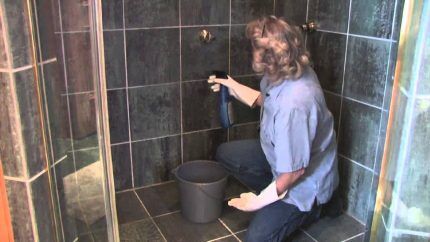
Factors that determine the rate of contamination of plumbing fixtures:
- Supplied water quality. The water coming from the central pipeline does not always meet the required parameters. And the reason for this is the increased content of salts and minerals in it, insufficient filtration of the system and worn-out water pipes.
- Availability of filters. An excellent solution when, to reduce the content of calcium salts in water and neutralize the effect of its other components, two main filters are connected at the inlet: coarse and fine.
- Care products used. It is strictly forbidden to use abrasive cleaners and hard brushes, the structure of which can damage any material of the shower cabin.
- Prevention is the most effective way to prevent the formation and overgrowth of fungal colonies. Once a fungus appears, it can settle for a long time and gain a foothold in microcracks in the facing material. The owner’s task is to eliminate favorable conditions for the development of fungus by reducing the humidity in the room by installing a forced ventilation system and regularly treating hard-to-reach areas of the booth using “chemicals.”
Foreign-made shower stalls for the most part are not designed for hard water coming from our plumbing systems.
Plumbing, taking into account Russian realities, may simply fail within a few years from the moment of commissioning. Information about popular breakdowns and shower room renovation discussed in our other article.
Many breakdowns can be prevented by changing the quality composition of the incoming water.
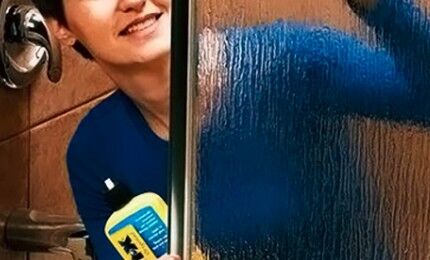
When choosing a detergent, it is important to take into account the features of caring for this material, since not only the efficiency and speed of cleaning, but also the service life of the plumbing fixtures depends on the correctness of the decision.
Maintenance is complicated by the fact that several types of materials are involved in the production of plumbing fixtures:
- pallets are different by design and type of material - in budget models it is made of acrylic or steel, in expensive ones it is made of natural or artificial stone, but there are shower models without tray;
- the roof, doors and walls of the cabin are made of transparent plastic or thick tempered glass;
- taps, mixers and shower heads can be either completely metal, made of chrome and stainless steel, or with the inclusion of plastic elements;
- The structure frame is made of painted aluminum profile.
Modern shower stalls are equipped with sophisticated plumbing equipment, for example, steam generating device. The owner’s task is to follow the rules of care for him.
Does your shower stall have an acrylic tray? Then you might be interested in our article on care behind the acrylic bathtub. Effective cleaning products, removing stains from the acrylic surface of the tray, as well as repairing scratches, is similar to caring for an acrylic bathtub.
The optimal solution to the problem is to create an arsenal of tools that are specifically designed for each type of material.
Although this approach will initially cost more, it is ultimately more profitable. After all, targeted means are more effective, and therefore will be spent more economically.
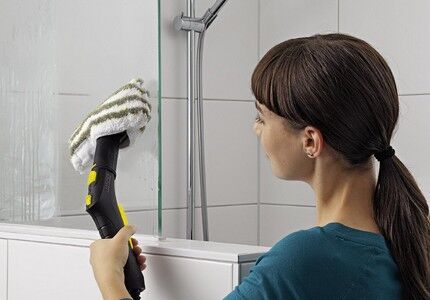
To remove old dirt and wipe the surface, it is best to use:
- a piece of soft fabric (flannel or cotton);
- silicone or rubber scraper (for collecting and dispersing water);
- foam sponge.
It is convenient to remove old dirt with a rubberized cloth, which can be purchased at any auto supply store. Many car enthusiasts love to use it for polishing cars.
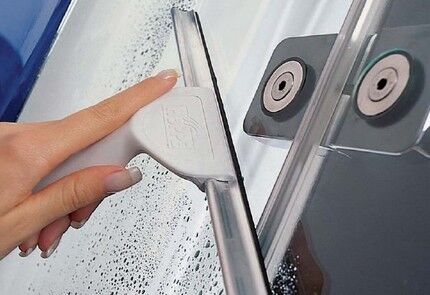
Do not attempt to clean chrome with steel wool or a piece of sandpaper. Each new, even the smallest scratch, will only increase the access of oxygen, accelerating the rusting process.
Review of effective cleaning products
A range of ready-made cleaning products designed for washing sanitary ware (both hydrobox and bathtub) is quite wide. Gels and creams, powders and sprays, concentrates and ready-to-use formulations...
The choice is limited only by consumer preferences.

Among the commercial products intended for the care of shower stalls, the most proven ones are:
- "Tilex" - an effective cleaning and antibacterial product made in the USA. Excellent for removing dried foam and fatty deposits. Does not require rinsing after application.
- "Cif" - a creamy cleaning composition with a thick consistency, produced under the trademark of the Dutch-British company Unilever. On sale it is found with bleaching and flavoring additives.
- "Akrilan" — the effective composition of the domestic manufacturer copes well with dirt, rust and white deposits. The presence of a spray bottle that sprays foam makes it possible to use the product as economically as possible.
An important point: when choosing which product is best to clean the shower stall, keep in mind that compositions based on alcohol, acetone and ammonia can deform the structure of the plumbing coating.
Detergents from scrap materials
Housewives who do not accept the use of “chemistry” often resort to time-tested folk methods. Their operating principle is based on the reaction between acid and calcium and magnesium salts.
As a result of the interaction of the media, the dissolution of limescale occurs.
Remedy #1 - citric acid solution
A powder with a crystalline structure, which has a sour taste, which many housewives use as a food additive, perfectly dissolves plaque on glass and plastic surfaces.
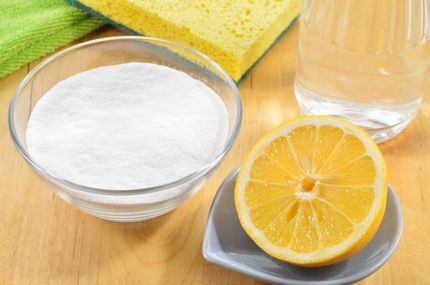
To prepare the solution, one packet of acid is diluted in 150 ml of cold water.
If possible, you can safely replace the acid with freshly squeezed lemon juice. The ratio of ingredients in the preparation of the cleaning composition is as follows: juice of one lemon to half a glass of water.
The diluted product is poured into a bottle equipped with a spray bottle and distributed evenly over the entire surface. In the absence of a spray bottle, the product can be applied with a foam sponge soaked in the solution.
Chrome parts can simply be wiped with a lemon wedge without further rinsing.

To achieve the maximum effect of the acid, leave the treated surface for 10-12 minutes. After this, rinse off with cold water and wipe dry.
If after cleaning there are still plaque residues, when re-processing it is recommended to increase the acid concentration by using two packets of powder for the same volume of liquid.
Remedy #2 – tooth powder or paste
Tooth powder is a mild and safe cleaner for enamel surfaces. It is also effective in removing white deposits from chrome taps and fittings.
When working with powder, spread it evenly over the surface and then wipe with a damp cloth.
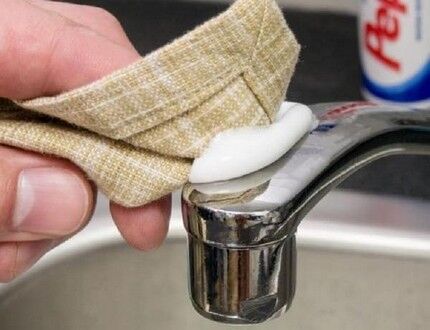
For cleaning, it is recommended to use a white paste. The pigments present in the multi-colored paste can irreversibly color the acrylic. After such “painting” it will no longer be possible to return the original whiteness to acrylic.
Apply the paste to the contaminated area with a soft sponge and rub gently in a circular motion. If it is necessary to remove more complex contaminants, leave the treated area for 20-30 minutes and only then rinse.
The seams in the shower stall and between the tiles can be cleaned well with an old toothbrush with a layer of toothpaste applied to the bristles.
Remedy #3 – vinegar for disinfection
Vinegar is able to easily dissolve the plaque of mineral salts present in water, without leaving a thin film on the surface, which is often observed when using store-bought “chemicals”.
In addition, it is capable of destroying 80-90% of all viruses and bacteria.
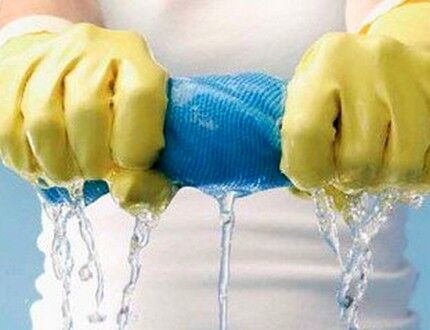
For processing, use an acetic solution diluted in water in a 1:1 ratio. Particularly contaminated areas can be cleaned with undiluted vinegar.
When applying the vinegar solution, it is most convenient to use a nylon sponge that absorbs moisture well.To remove scale from nickel-plated taps and pipeline connection points, it is convenient to use cotton napkins soaked in vinegar.
To achieve the desired effect, it is enough to wrap the treated area with a piece of cloth soaked in the concentrate and leave for 30-60 minutes. After this, all that remains is to rinse the elements with clean water and collect the remaining moisture with a dry cloth.
Remedy #4 - vodka or alcohol
Soap scum often accumulates on the glass doors of the booth. As it dries, it gradually turns into whitish spots that have an unpresentable appearance.
Ethyl alcohol cleans glass best from soap splatters. And the real threat of soap stains is ammonia.

To prepare the detergent, 5 ml of alcohol is diluted in a container with 5 liters of water. To simplify cleaning, it is recommended to use alcohol in combination with vinegar.
To create the effect of a glossy shiny surface, covered with a thin film that helps repel soap and minerals, it is worth adding 20-40 ml of glycerin to the composition.
Daily shower care
The statement that it is much easier to wash off fresh stains than to scrub off old stubborn stains has long become an axiom for many housewives. Daily care is intended only to maintain the cleanliness achieved during general cleaning.
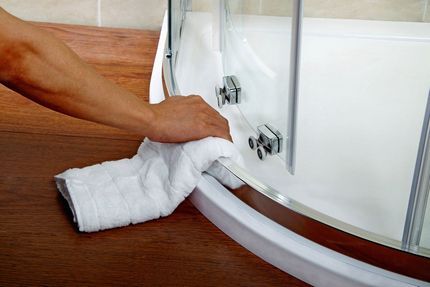
To maintain a neat appearance of plumbing fixtures, cleaning is performed in the following sequence:
- After taking water procedures with warm water, rinse all surfaces of the hydrobox with jets of first hot and then cold water.
- Use a rubber roller or scraper to remove all water from the walls of the box.
- Use a microfiber cloth to wipe the entire booth dry in order to remove any remaining water droplets that, when evaporated, leave behind a mineral deposit.
When washing the walls, special attention should be paid to the corners where soap scum always accumulates. To maintain the presentability of chrome-plated plumbing elements, during daily maintenance they must be thoroughly washed and each time thoroughly wiped with a dry cloth.
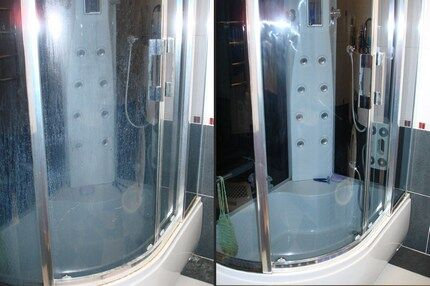
Don't think that this will take a lot of time. The procedure takes no more than one minute. And the result can please you for several hours before the next water treatment.
General cleaning of plumbing
Scheduled cleaning is performed every 7-10 days. The frequency of the procedure depends on the intensity of use of the device by household members.

Regular ablution without the use of detergents is not able to provide the required result. Therefore, when carrying out a general cleaning, it is mandatory to use detergents for shower cabins.
Key points to consider when carrying out general cleaning:
- Removing limescale. Cream and paste products based on fruit acids cope best with this task.They easily dissolve dirt, but at the same time prevent fading or, conversely, darkening of the surface.
- Cabin glass cleaning. Caring for transparent glass is not much different from the technology for treating any glass surface. The selected product is applied by spraying onto the walls of the cabin and left for 5-7 minutes, after which it is wiped clean with a dry piece of lint-free cloth.
- Cleaning the cab pan. When processing acrylic pallets, in order not to scratch the smooth walls, use cleaning agents that have a whitening effect. They do not contain abrasive particles. It is recommended to treat stone pallets with a steam cleaner, using a minimum of “chemicals” that can cause darkening of the stone. For enamel trays, cream- and gel-like products such as “Komet” and “Pemolux” are best suited.
- Getting rid of mold. Achieve results with mold removal only possible through the use of chlorine-based compounds. To do this, black spots are treated with “chemistry” and left for 30-40 minutes so that the product penetrates into the pores and cracks.
In cabins where the walls are tiled, it is better to use concentrated compounds designed to care for tiles to remove dirt.
When processing facing materials, it is necessary to treat the seams between the tiles with special care, since they are often the breeding ground for mold.

When you use “chemistry” when treating the surface, make sure that there are no small children or pets nearby, and that the room itself is well ventilated.
It is recommended to work with chemical detergents wearing thick household gloves.
It is constantly necessary to monitor the condition of taps, nozzles, shower heads and other metal parts. They may become covered with calcium deposits. Treatment with concentrated compounds designed to eliminate any kind of plaque helps to successfully cope with this task.
Poor quality water can even clog the holes of nozzles and showers.

After mechanical cleaning, the watering can should be additionally soaked in a vinegar solution. To do this, the divider is lowered for 30-60 minutes into a container filled with vinegar solution diluted with water in a 1:1 ratio.
The filters installed at the inlet also require maintenance. In order for filter systems to efficiently perform their functions, it is necessary to clean their elements from time to time, and, if necessary, completely replace them with new ones.
In the future, the use of hydrophobic compounds will help make everyday care easier. They are applied to the plumbing fixtures at the final stage of cleaning, evenly distributed over the dry surface.
After hardening, they form an invisible water-repellent film, thanks to which housewives have to return less and less to the problem of having to clean their plumbing fixtures from soap and limescale deposits.
Conclusions and useful video on the topic
You might find some helpful tips provided by experts to be helpful.
Tips for choosing drugs:
Guidelines for preparing a composition using improvised materials:
There is nothing difficult in choosing the right products for cleaning the shower stall, simplifying your daily chores.
If you regularly clean the walls and drain of the hydrobox, turning plumbing care into a daily habit, then general cleaning will only have to be done a couple of times a month.
Have you found the ideal product to care for your shower stall and want to tell other owners of similar plumbing equipment about it? Or do you use an effective solution prepared from improvised materials? Share your master's secrets - leave comments on this article.




The cabin, of course, is modern and comfortable, but it requires much more care than a standard bath. I found two products for myself that work well in my conditions. For cleaning I use yplon paste, it has almost no smell and removes limescale well. And for doors - ludwik anti-steam. In my opinion, the fogging of the glass has not decreased, but it cleans well. Alas, we are unable to take care of the cabin after every wash.
I noticed that the shower stall began to get dirty very quickly. Stains remain, some yellow smudges, probably rust. I usually wash the cabin with various detergents that are in the apartment and with a sponge. Then I wipe it dry and that’s it. I decided to try wiping it with alcohol. It turns out well, it then shines and disinfects at the same time. And the smell from alcohol disappears quickly.
Recently, a lot of soap stains and some white spots have appeared on the shower stall. I usually remove them once a week using detergents, but more often than not it doesn’t work. I decided to follow the advice and use alcohol, but I didn’t have any at home, so I took regular vodka. She rubbed it, then wiped it dry. Now the appearance is much better, I decided for myself that it is easier to do this every time after use than to wash off old stains later.
Good afternoon. I bought an antibacterial product for shower stalls, but after using it, a yellow coating appeared in places on the glass doors. It is not present everywhere, but somehow in patches... I wanted to wash it, but nothing can remove it. Has anyone encountered this and how to remove it?
Hello. try melamine sponges. In Fix Price 50 rubles for 2 pieces, on Aliexpress it’s even cheaper. Do not apply detergents to the sponge.
Good afternoon everyone. Why complicate everything so much?! It's simple! You need to protect the glass and forget about it... I did this 5 years ago using ClearSheld and no longer wash or SMASH the glass in the shower. I just rinsed it with water and that’s it! No soapy dirt or residue...
As for glass, it is indeed very convenient and practical to apply a film with ClearShield technology to them. But a shower cabin is not only glass doors, but also a lot of other things: tiles, tray, shelves, chrome parts of the faucet and shower - all this requires care. Yes, you can, apply the film to the glass and forget about limestone deposits for five years. But this does not apply to other parts of the shower stall.By the way, this film can also be used on ordinary windows, which is what I actually recommend doing.
But to maintain all other parts of the shower stall, the article provides practical advice. Or do you just keep the glass in the shower stall clean? 🙂
Where can I buy clear shield?!
Hello. On the official website of this company you can purchase this product, as well as obtain information on where to purchase this product.
I’m currently using Glutoclean shower cleaner, it removes stains very well and doesn’t leave streaks.
Can you tell me if GLUTOCLEAN will cope with limescale, this is my pain (our water is hard
Help, the shower cabin is glass, I tried everything that is said in the article, nothing helps, it seems to be shiny, but when you turn off the light and shine a flashlight, the coating is simply terrible, I don’t know how to wash it, it doesn’t help at all